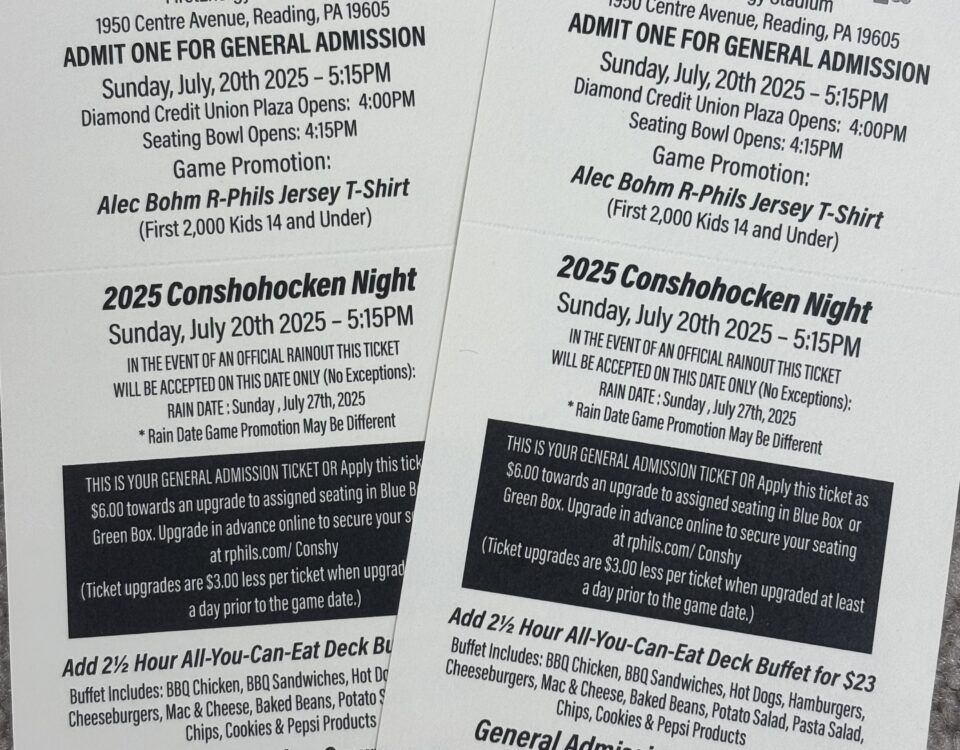
Shirt of the Month – Throwbacks
September 28, 2023
SaiGon Noodle Kitchen Soft Opening
October 15, 2023History of a House – 213 Spring Mill Avenue – Home to Francis “Bunny” Blake
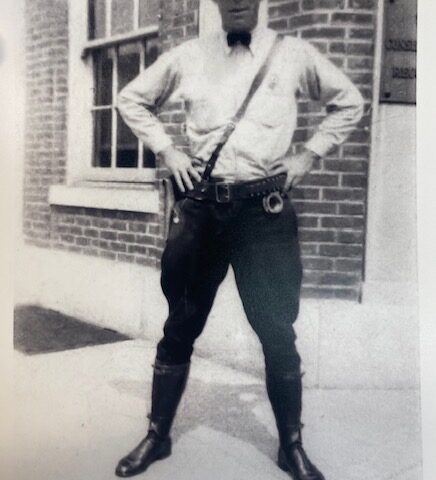
History of a House
213 Spring Mill Avenue
Francis “Bunny” Blake
A Boxer, A cop, A Hero
And All Around, Just a Good Guy
By Jack Coll
Almost all the houses on Spring Mill Avenue from the 100 block thru the 600 block were built before the turn of last century. A few of the homes still standing were built as early as 1865 and nearly all the rest were built before 1900. Spring Mill Avenue is an eclectic assortment of houses featuring everything from Victorian Vernacular, to Victorian Second Empire to Colonial Revival to Craftsman style houses along with many others architectural styles.
The three-story structure house located at 213 Spring Mill Avenue where Francis “Bunny” Blake once lived for many years was built circa 1880, and is one of a number of the Victorian Italianate style houses along the Spring Mill Avenue strip.
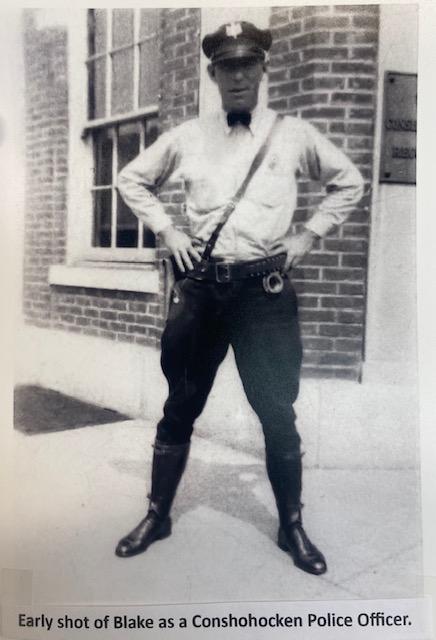
Bunny was born in Connaughtown, Plymouth Township, in 1900, he was the son of James and Elizabeth Blake, and was a lifelong resident of Conshohocken and a graduate of St. Matthew’s High School and attended Villanova College.
Bunny, and his wife Grace had two children Francis and Ann and lived at 40 Fayette Street, until they purchased their own house at 213 Spring Mill Avenue in 1952. During their time on Fayette Street, they lived above D’Annunzio Brothers Jewelry Store. The D’Annunzio Brothers were long time staples in the borough and sold Diamonds, Watches and Jewelry for more than two decades. D’Annunzio’s Jewelry was located between Pater’s Bakery at 38 Fayette Street and what would become May’s Luncheonette at 42 Fayette Street.
Blake enlisted in the army in 1917, when he was 17 years old, Serving as a private with the Quartermaster Depot during World War l. Upon discharge, he became a well-known professional boxer. High spot of his career came when he fought Tommy Loughran, known as the “Phantom of Philly” who later became the Light heavyweight champion of the world. Blake also served as a sparring partner for Loughran six months after the two fought, and Loughran won the title, overall, Blake fought a total of 143 professional fights.

Blake was a boxer during Conshohocken’s Golden Era of Boxing throughout the early part of the century. There was Anthony Rossi, a premier lightweight known as Midge Fox, Casimer Grablewski, an East Elm Street resident known as Johnny Craven was known as “The Comeback Kid” in the ring, perhaps Conshohocken’s greatest boxer.
Big John Cassinelli, a heavyweight who was a very imposing figure in the ring, and Joey Hatfield, a lightweight contender. Topsy Campbell was one of Conshohocken’s early boxers, Joey Blake, who fought during the same era as Bunny Blake was a feared Conshohocken south-paw. Bunny Blake was a middleweight boxer who was said to outbox, outslug and outwit his opponents. In July of 1926, Blake fought Wild “Buck” Fleming of Manayunk in Manayunk and won the applause of the mob in “Buck’s” hometown. Bunny put on a show that hot July night with his clever jab and vicious punching along with good defense. The sports page of the local Recorder newspaper described the fight stating, “Blake cut a deep gash over Fleming’s eye in the fifth round, a hard right jab and had Fleming’s face covered in blood throughout the remainder of the fight. The decision of the judges met with the approval of the crowd.” Blake had many glorious fights according to local newspapers, to many to mention.

Other boxers from the borough included Jack Harrold, Wally Novak, Jimmy DeCerio and others, many of them trained at Johnny Kelly’s gymnasium once located at 12 East Hector Street.
Blake joined the Conshohocken Police Force on July 2, 1929 an became known as the “Dean of Conshohocken Policeman” and except for a brief leave of absence during the second world war, he served this community continuously for the next 32 years as one of Conshohocken’s finest.

In 1942 America was involved in World War ll and in November of that year both Officers Bunny Blake and Daniel Donovan were granted a leave of absence and entered into the military Service.
The two would be reinstated upon discharge from the military and return to the police force. Taking their place on the force were F. Walter Bischof of West Sixth Avenue, operator of an automobile repair shop on Forrest Street below Hector Street and Louis M. Householder, who resided at 300 West Sixth Avenue and is employed at the Schuylkill Iron Works of the Alan Wood Steel Company. The two replacement officers will be paid the exact same as other patrolmen on duty, $1742 a year.
During World War ll Blake specialized in police work. He first served as Chief Petty Officer in charge of all shore patrol work on street duty in the Philadelphia area, where he had charge of all other chiefs and enlisted men.
Blake was later assigned directly under Commander W. E. Brougham in Pittsburgh, in charge of all shore patrol and disciplinary action in Western Pennsylvania and in the Fourth Naval District.
Upon his release from the military service at the end of the war, Blake returned to duty as a police officer and continued his stellar career fighting crime on the streets of Conshohocken, which was a very different Conshohocken than the one we know today.

As I peel through my files on Bunny Blake, I see I have way too many of his crime-stopper incidents to report on so I’ll just hit a couple of highlights of his career. It started with the very day he was hired. Prohibition was in effect, and it was up-to Blake along with other officers of the time like Frank Jacquot, Michael Bosco, Harry Williams and of course Chief Daniel Donovan to track down and arrest bootleggers, Moonshiners and “shine runners” involved in breaking the laws of prohibition.
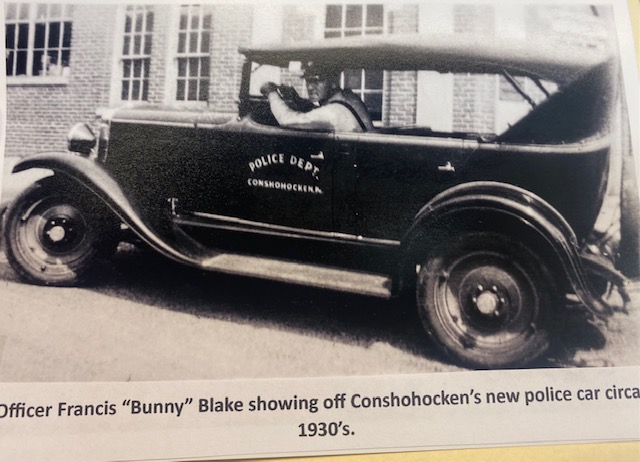
If you don’t know, or need a little refresher, prohibition started with the Women’s Christian Temperance Union, (including the Conshohocken Chapter), and if you didn’t know the Conshohocken branch of the Temperance they had their headquarters at the corner of West Third Avenue and Forrest Street, currently an office building. The Temperance Union cried out to local and national leaders for a national prohibition in the United States. They believed it would protect families, women and children from the effects of alcohol abuse.
In 1919, legislatures around the Country ratified the 18th Amendment to the Federal Constitution, enabling National Prohibition within one year of ratification. On January 16, 1920, the 18th amendment went into effect.
During Prohibition, the manufacture, transportation, import, export and sale of alcoholic beverages were restricted or illegal. Prohibition was supposed to lower crime and corruption, reduce social problems, lower taxes needed to support prisons and “poorhouses,” and improve health and hygiene in America.
Instead, alcohol became more dangerous to consume; organized crime blossomed; courts and prisons systems became overloaded; and endemic corruption of police and public officials occurred.

And all that my friends brings us back to Conshohocken and Bunny Blake! In Conshohocken and West Conshohocken, “speakeasies” and other underground drinking establishments flourished throughout the boroughs. Adding to the lawlessness of the two communities were hundreds of drinking bars. On Saturday nights, Ford Street in West Conshohocken looked like a tourist town with all the visitors coming and going. In Conshohocken, Hector Street, Elm Street, Lower Maple Street and all of Connaughtown seemed to have more visitors than residents. They were all coming for the “hootch.” For Officer Blake and the rest of the squad, it became a full-time job just handling the violators of the 18th amendment, not to mention all the illegal gambling going on in a number of gambling halls in both boroughs.
There was the 1931 murder of popular resident Ralph Spanish, that led Conshohocken police down a dark road of Bookies, gamblers, a mysterious missing blond woman, gambling halls throughout the lower end of the borough that were rumored to be run by local mobsters. That whole case that Officer Blake was involved with is another story for another time.
When Blake joined the police force in July 1929, little did he or anyone else know that the country’s worst depression was staring them in the face and it was only a little more than three months away from the time Blake was hired. The great depression that collapsed the nation’s economy in October of 1929, didn’t have a great effect on Conshohocken’s economy however it put a strain on our banks. Howard Pedrick, president of the Conshohocken National Bank then located on the corner of Hector and Fayette Streets and lived at the corner of Sixth Avenue and Fayette Street embezzled more than $45,000 in 1931 and when confronted, it led Pedrick to a murder-suicide that left Blake and his fellow officers to figure out the aftermath of his actions, again, another story for another time.
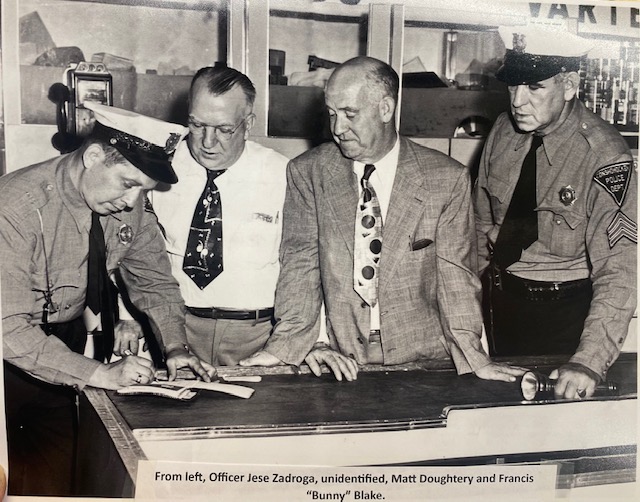
A robbery from March 16, 1930, was solved by Conshy and state Police. A young man from North Philadelphia confessed to Blake and State troopers that he robbed the Almar Store once located at Seventh Avenue and Hallowell Street. Blake had been on the case for a couple of months and learned the suspect was in Conshohocken at the time of the Almar robbery. The suspect, who had worked at the store seven years earlier when it was owned by the Tole Grocery Company. The suspect and a companion stole a safe, cigarettes and other goods from the store.
The two placed the safe on the running board of a car they stole in Philadelphia and headed towards Germantown Pike. As they drove away, they noticed a car following them, it was officer Harry Williams of the Conshy police force. Williams fired several shots as a chase ensued.
Blake stayed on the case for nearly a year before cracking the two suspects.
Two Men held-up Robert Cardamone’ Drug Store at 826 Fayette Street in April of 1931, robbing Cardamone’s 16-year-old brother Edward, whom with another brother Philip, 20 years old, were both in charge of the store at the time of the crime.
Police officers Francis Blake and Sergeant Frank Jacquot responded immediately and learned that a man had robbed the store with a running automobile waiting out front. One man entered the store the other waited in the car.
The bandit walked up to Edward with his nose and mouth covered with a handkerchief and said to Edward, “I know you” to which Edward replied “I know you too,” after taking the money the bandit ran out of the store and jumped into the automobile and they drove off.
Blake and Jacquot hurried to Norristown to hunt for the bandit. Blake hid outside the bandits home while Jacquot went to the Norristown city hall. As officer Blake was in hiding the suspect arrived at his home. As he was about to enter, he was accosted by Blake who took him into custody. (of course, Blake had to hold onto the criminal until his ride showed up, waiting for Jacquot to return from city hall)
Eventually the bandit’s accomplice was captured and Blake and Jacquot linked the pair to an identical hold-up at Herbert Tole’s store a few weeks earlier.
From December 3, 1925 until December 9, 1932 Conshohocken Police were on high alert for escaped convict Michael Antonlini better known as Black Mike who had murdered a Conshohocken Police officer, Eugene “Chick” Lucas in 1917. When Blake had joined the force in October 1929, he was notified that Black Mike was on the run and had been since escaping from the Montgomery County Prison once located in Norristown. Members of the Conshohocken Police Force which now included Blake, were on the look-out for Black Mike thinking he might return to Conshohocken. However, after a massive manhunt came to a close in Canada upon Black Mike’s capture in December of 1932 residents and members of the Conshohocken Police Force were able to breathe a sigh of relief.
In 1934, when Blake was named Chief of Police, he acted quickly to bring Conshohocken’s very first protest demonstration to a halt. The protest involved Perry Smith, the town’s school crossing guard and several hundred school children who marched to borough hall and the Police station to protest the firing of Mr. Smith. When no-one else could figure out how to handle the protesters it was Bunny Blake who came up with the solution and Mr. Smith was back at his crossing station the following day thanks to Blake.
Then there was the great train robbery at the railroad station in 1934, where five armed bandits walked off with $17,000 in cash that was meant for local mills to be used for payroll. The five men were eventually captured at the hands of Chief Blake.
A little side-something, in 1944, after Blake returned from World War ll, the police department was without a police car for 53 days. The police were forced to use their own cars or just walk the beat on foot, the cops were force to be in good shape back then.
In 1959 Samuel Reidenberg, a Fayette Street grocer was murdered on January 17, on Samson Alley located just behind his place of business at 59 Fayette Street. Chief of Police Walter Phipps put Sargent Blake in charge of the murder investigation along with officers Samuel Cardamone, John Mazur and Matt Dougherty who joined forces with Montgomery County Detectives. It became Conshohocken’s only unsolved murder case, and remains a cold case.
Also, in December of 1959, Blake was dealing with the Elmo Smith murder of Maryann Mitchell. The 38-year-old handyman from Bridgeport abducted her in Roxborough, killed her at Eighth Avenue and Spring Mill Avenue in Conshohocken and dumped her in a roadside gully on Harts Lane in Whitemarsh. The Mitchell murder case became the most sensational murder case in Montgomery County history. Blake worked on that case with Philadelphia and County detectives, Blake retired following the conviction of Smith. Smith was executed at 9:01 P.M. on April 2, 1962, nearly one year to the day after Blake retired.
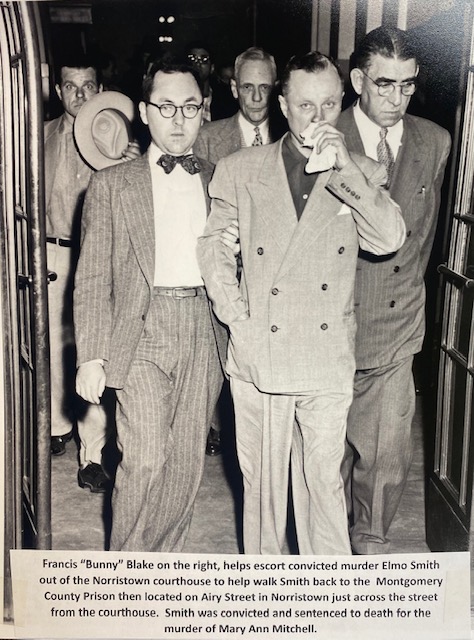
Bunny Blake retired on April 3, 1961, following 32 years of service. Bunny was honored for his service at the 1961 Conshohocken Police Ball. He was presented with a U. S. Savings-Bond by Charles Marwood, Conshohocken Chief of Police, Walter McLaughlin, Special agent, Federal Bureau of Investigation, James Mellon, Burgess of Conshohocken and Police Sgt. Raymond Alexander. Blake had been honored and received many awards over the years, too numerous to mention.
At the time of Blake’s retirement Chief Charles Marwood was making $6,000 a year, Sgts Raymond Alexander and Francis Bunny Blake were making $5,000 per year. When Blake joined the force in 1929 Conshohocken Police Officers were making less than $200. A month.
Officers at that time of Blake’s retirement were using a police car purchased in 1959 from E. F. Moore Chevrolet that cost $1,600 new.
Following retirement from the Conshohocken Police Department Blake served as a Montgomery County Sheriff until 1968.
Blake passed away in March of 1968, at the age of 68. He was an extremely popular policeman, a professional Boxer, and a veteran of both World Wars. He lived at 213 Spring Mill Avenue with his wife Grace, the couple had two children Francis and Ann. Blake was a member of the Washington Fire Company, Fraternal Order of Police and the American Legion, John F. DeHaven Post.
I thought it might be interesting to look back and reflect on a few things and events that took place during Bunny Blake’s life-time!
A few interesting side notes :
Blake was born in 1900 when Conshohocken had no paved roads and trolley cars could be seen and heard rumbling up and down Fayette Street and along East Hector Street.
In the year 1900, the President of the United States was William McKinley, Milton S. Hershey introduced the Milk Chocolate Bar, (I know that my wife, and women throughout the world are forever grateful)
In New Haven, Connecticut Louis Lassen of Louis Lunch, made the first modern day Hamburger. (And I know Popeyes friend Wimpy is forever grateful).
In 1905 Conshohocken had a World Championship Basketball Team, their team photo hangs in the Nesmith Basketball Hall of Fame in Springfield, Massachusetts.
He witnessed the 1919 Conshohocken Professional Football team win the Eastern Seaboard League Championship, their team photo hangs in the National Football Hall of Fame in Canton, Ohio.
He witnessed football games at the Conshohocken Community Field where up-to 10,000 fans per game would show up to root for the Conshy Pros.
The influenza pandemic of 1918-1919 resulted in an estimated 25 million deaths worldwide, though some researchers have projected that it caused as many as 40-50 million deaths
In the United States about 550,000
78 Conshohocken residents lost their lives
10 West Conshy residents died
Blake lived in a time that the boroughs of Conshohocken and West Conshohocken were connected by an iron bridge, before the concrete bridge was built in 1921.
He live through the prohibition years and the Great Depression, witnessed two World Wars, mourned with the rest of the country when President John F. Kennedy was assassinated and Blake died a year before America put a man on the moon.
The year Blake was born the American League Baseball organized in Philadelphia with eight founding teams including the Philadelphia A’s headed by Connie Mack.
Also, in the year 1900 Casey Jones died in a train wreck in Vanghan, Mississippi while trying to make up some time on the Cannonball Express.
In 1921 Conshohocken residents were ecstatic over the opening of the Riant Theatre once located at First Avenue and Fayette Street. Silent movies were all the rage until talkies became available and were introduced at the Riant Theatre in 1928.
In 1929, the same year of the Wall Street Crash, the St. Valentine’s Day Massacre took place, that was a gang related shooting in Chicago. There was a lot of press about the opening of the San Francisco Bay Bridge and the first Academy Award/Oscar Ceremony took place in Hollywood Ca.
Also, in 1929, the year Blake became a police Officer, he was witness to the invention of the first car radio by Motorola, Mobster Bugsy Siegel married his childhood sweetheart, Howard Hughes divorced his first wife Ella after four years of marriage and Herbert Hoover was President of the United States.
By the 1940’s gas prices raised to between 15 and 17 cents per gallon at stations like Tancini’s and Son once located at 701 Spring Mill Avenue, Frank Allen’s Service Station in West Conshohocken, Coder’s Esso Station at North Lane and Butler Pike, (Currently Bowe’s Exxon Station) and Ferraioli’s Esso Station once located on Elm Street. , but not many area residents noticed because the Philadelphia Eagles won back-to-back championships in 1948 and 1949.
In the 1950’s the Riant Theatre was part of Hollywood’s golden years with movies like “From Here To Eternity,” “Peter Pan,” “The War of the Worlds,” “Shane,” “On The Waterfront,” “Rear Window,” “White Christmas,” “Rebel Without A Cause,” “East of Eden,” “The Seven Year Itch,” “An Affair to Remember,” “Vertigo,” “Gigi,” “Ben Hur,” “Some Like it Hot,” “Sleeping Beauty,” The African Queen,” “A Streetcar Named Desire,” Alice in Wonderland,” and “An American in Pais,” and so many more. I’m sitting here wondering how many of these movies do you remember?
In 1961, Alan Shepard made his first U. S. Space flight, the construction of the Berlin Wall began to divide East and West Germany and the Bay of Pigs invasion failed as Cuba and the CIA tried to overthrow Castro.
In August of 1961 Motown Records released its first Number One hit, “Please Mr. Postman” by the Marvelettes and the Dick Van Dyke Show premiered on CBS.
A few weeks ago, Conshystuff ran an article pertaining to a little bit of history on the Conshohocken Police Force, and in that article, We mentioned Bunny Blake and how he saved a little girls life when she was apparently drowning while cooling off in Gulph Mills.
We thought the story was worth repeating so here it is below:
1930
Officer Blake Saves Child
Saw Child Slip Into Deep Water at Balmoral Dam.
Swam under water—catching child as she sank in deep water
Presence of mind displayed by Officer Blake of the local police force, saved Nancy, seven-year-old daughter of Mr. and Mrs. James Maguire, 829 Ford Street, West Conshohocken, from drowning in the Balmoral Dam at Gulph Mills, Wednesday afternoon when the child stepped on a slippery stone and was precipitated into water several feet deep near the flood gate. Nancy was spending a few days with her grandmother, Mrs. Elizabeth Maguire of Gulph Mills whose home is located close to the Gulph Creek.
Officer Blake who had gone to the dam to bathe in company with a group of swimmers was standing on the bank at the time watching the child. He knew of the slippery condition of the stone wall; he realized the perilous position of the children and no sooner had the child disappeared beneath the water than the officer pushing aside a number of the swimmers dove from the bank and swam to the spot where the child sank from view.
He was lost from the crowd for a minute. Few if any of the large crowd on the bank know what the officer meant presently, he came to the top of the water holding the child in his big strong arms, the muscles in which have been strengthened from continued intensive training in the prize ring.
Holding the frightened child in one arm he swam with the other to the shore and she was tenderly placed in the care of her grandmother badly frightened but none the worse for the unpleasant experience.
Believe it or not, that was the third rescue Officer Blake had made at the Balmoral Dam.
Looking back on the life and times that Bunny Blake lived and served our community is simply amazing to me. When I think about what he witnessed in his lifetime, and what he did and accomplished, is nothing short of fascinating. From dirt roads to nearly a man on the moon.
If Bunny Blake was able to visit Conshohocken today, I’m sure he wouldn’t recognize Lower Conshohocken, nor would he recognize upper Spring Mill Avenue, once the site of Hale Fire Pumps. But the house where Blake lived at 213 Spring Mill Avenue has changed very little. The fact that his son Franny and his wife Harriet live in the house would bring a smile to his face.
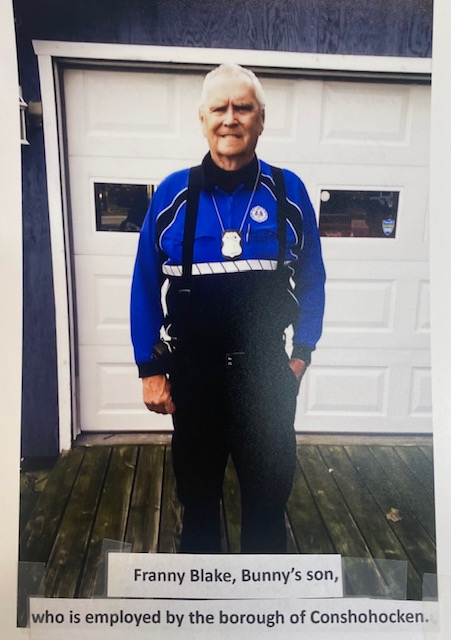
Franny can be seen walking the streets of Conshohocken saying “Hello” and greeting residents, and always happy to stop and talk about his father. Ask him about his father being a cop on the beat back in the good old days, and ask him about the time his father spent with Jack Dempsey!
This article didn’t allow me the space to cover Blake’s boxing career, perhaps another story for another time. If we could ask Blake about his boxing career, I’m sure he would say it was just another chapter of his life, but to me it’s pretty fascinating.
Thanks for the memories
For more great articles on History of a House visit Conshystuff.com and click on articles by Jack Coll where you’ll find nearly 40 interesting History of a House segments.

